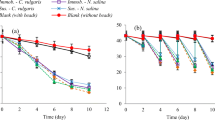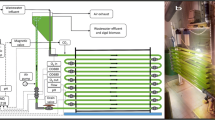Abstract
A novel aqueous silica removal process using naturally occurring diatoms for water and wastewater treatment, in particular water reuse and desalination, was developed. Brackish agricultural drainage water containing 39 mg L−1 of total silica and 10 g L−1 of total dissolved solids was used as a source of silica-assimilating diatoms. The drainage water was statically incubated in 500-mL and 7.5-L photobioreactors at 27 ± 2 °C under continuous illumination using two 13-W compact fluorescent light bulbs as a light source. After 10 days, brown algal biomass became noticeable and silica removal started to occur. Silica removal accelerated as algal biomass accumulated. In the fourth semi-batch cycle, more than 95 % of molybdate reactive silica was removed within 28 h. Removal of nonreactive silica was also confirmed. Reverse osmosis concentrate samples from advanced water reclamation facilities with high silica concentration (>120 mg L−1) were also tested. More than 75 % of silica was removed within 6 days. Microscopic analysis revealed the presence of Pseudostaurosira, Nitzschia, and Halamphora species in the photobioreactors. To the best of our knowledge, this is the first report on the use of diatoms for aqueous silica removal in water treatment.






Similar content being viewed by others
References
APHA, AWWA, and WEF (2005) Standard methods for the examination of water & wastewater, 21st edn. American Public Health Association, Washington, DC, pp. 4-164–4-165
AWWA (2010) Algae: source to treatment—manual of water supply practices – M57, 1st edn. American Water Works Association (AWWA), Denver, p. 219
Asano T, Burton FL, Leverenz HL, Tsuchihashi R, Tchobanoglous G (2007) Water reuse: issues, technologies, and applications. McGraw-Hill, NY, pp. 487–492
Bradbury J (2004) Nature’s nanotechnologists: unveiling the secret of diatoms. PLoS Biol 10:306
Bien GS, Contois DE, Thomas WH (1958) The removal of soluble silica from fresh water entering the sea. Geochim Cosmochim Acta 14:35–54
Behrman AS, Gustafson H (1940) Removal of silica from water. Ind Eng Chem 4:468–472
Borowitzka MA (1987) Calcification in algae: mechanisms and the role of metabolism. CRC Crit Rev in Plant Sci 6:1–45
Bozarth A, Maier U-G, Zauner S (2009) Diatoms in biotechnology: modern tools and applications. Appl Microbiol Biotechnol 82:195–201
Caron DA, Garneau ME, Seubert E, Howard MD, Darjany L, Schnetzer A, Cetinić I, Filteau G, Lauri P, Jones B, Trussell S (2010) Harmful algae and their potential impacts on desalination operations off southern California. Water Res 42:385–416
Crittenden JC, Trussel RR, Hand DW, Howe KJ, Tchobanoglous G (2005) Water treatment: principles and design, 2nd edn. John Wiley & Sons, Hoboken, pp. 1592–1616
Egge JK, Aksnes DL (1992) Silicate as regulating nutrient in phytoplankton competition. Mar Ecol Prog Ser 83:281–289
Finkel ZV (2016) Silicification in the microalgae. In: Borowitzka MA, Beardall J, Raven JA (eds) The physiology of microalgae. Springer, Dordrecht, pp. 289–300
Gallego S, del Vigo F, Chesters S (2008) Practical experience with high silica concentration in RO waters. Proc. WIM 2008 International Congress on Water Management in the Mining Industry, Santiago, Chile, July 9–11, 2008
Gilpina LC, Davidson K, Roberts E (2004) The influence of changes in nitrogen: silicon ratios on diatom growth dynamics. J Sea Res 51:21–35
Gordon R (2010) Diatoms and nanotechnology: early history and imagined future as seen through patents. In: Smol JP, Stoermer EF (eds) The diatoms: applications for the environmental and earth sciences. Cambridge University Press, Cambridge, pp. 590–613
Greenleea LF, Lawlerb DF, Freemana BD, Marrotc B, Moulin P (2009) Reverse osmosis desalination: water sources, technology, and today’s challenges. Water Res 43:2317–2348
Grogera C, Sumper BM, Brunner E (2008) Silicon uptake and metabolism of the marine diatom Thalassiosira pseudonana: solid-state 29Si NMR and fluorescence microscopic studies. J Struct Biol 161:55–63
Grossart HP, Czub G, Simon M (2006) Algae-bacteria interactions and their effects on aggregation and organic matter flux in the sea. Environ Microbiol 8:1074–1084
Harrison PJ, Conway HL, Dugdale RC (1976) Marine diatoms grown in chemostats under silicate or ammonium limitation. I. Cellular chemical composition and steady-state growth kinetics of Skeletonema costatum. Mar Biol 35:177–186
Harper HE, Knoll AH (1975) Silica, diatoms, and cenozoic radiolarian evolution. Geology 14:175–177
Iler RK (1979) The chemistry of silica—solubility, polymerization, colloid and surface properties, and biochemistry. John Wiley & Sons, Hoboken
Kociolek P (2011) Nitzschia amphibia. Diatoms of the United States. http://westerndiatoms.colorado.edu/taxa/species/nitzschia_amphibia. Accessed 9 Feb 2016
Kang G, Cao Y (2012) Development of antifouling reverse osmosis membranes for water treatment: a review. Water Res 46:584–600
Lee KP, Arnot TC, Mattia D (2011) A review of reverse osmosis membrane materials for desalination—development to date and future potential. J Membr Sci 370:1–22
Lee RE (2008) Phycology. Chapter 17. Heterokontophyta. Cambridge University Press, Cambridge, pp. 360–408
Lewin JC (1954) Silicon metabolism in diatoms. I. Evidence for the role of reduced sulfur compounds in silicon utilization. J Gen Physiol 37:589–599
Lim GW, Lim JK, Ahmad AL, Chan DJC (2015) Influences of diatom frustule morphologies on protein adsorption behavior. J Appl Phycol 27:763–775
Martin-Jézéquel V, Hildebrand M, Brzezinski MA (2000) Silicon metabolism in diatoms: implications for growth. J Phycol 36:821–840
Matin A, Khan Z, Zaidi SMJ, Boyce MC (2011) Biofouling in reverse osmosis membranes for seawater desalination: phenomena and prevention. Desalination 281:1–16
McCree KJ (1972) Test of current definitions of photosynthetically active radiation against leaf photosynthesis data. Agric Meteorol 10:443–453
Morales EA (2001) Morphological studies in selected fragilarioid diatoms (Bacillariophyceae) from Connecticut waters (U.S.A.). Proc Acad Nat Sci Philadelphia 151:105–120
Ning RY (2002) Discussion of silica speciation, fouling, control and maximum reduction. Desalination 151:67–73
Nassif N, Livage J (2011) From diatoms to silica-based biohybrids. Chem Soc Rev 40:849–859
Paasche E (1973a) Silicon and the ecology of marine plankton diatoms. I. Thalassiosira pseudonana (Cyclotella nana) grown in a chemostat with silicate as limiting nutrient. Mar Biol 19:117–126
Paasche E (1973b) Silicon and the ecology of marine plankton diatoms. II. Silicate uptake kinetics in five diatom species. Mar Biol 19:262–269
Perez-Gonzalez A, Urtiaga AM, Ibanez R, Ortiz I (2012) State of the art and review on the treatment technologies of water reverse osmosis concentrates. Water Res 46:267–283
Sumper M, Brunner E (2006) Learning from diatoms: nature’s tools for the production of nanostructured silica. Adv Funct Mater 16:17–26
Spaulding S, Edlund M (2008) Pseudostaurosira. Diatoms of the United States. http://westerndiatoms.colorado.edu/taxa/genus/Pseudostaurosira. Accessed 9 Feb 2016
Stepanek J, Kociolek P (2010) Halamphora veneta. Diatoms of the United States. http://westerndiatoms.colorado.edu/taxa/species/Halamphora_veneta. Accessed 9 Feb 2016
Villacorte LO, Ekowati Y, Winters H, Amy GL, Schippers JC, Kennedy MD (2013) Characterisation of transparent exopolymer particles (TEP) produced during algal bloom: a membrane treatment perspective. Desalin Water Treat 51:1021–1033
Vrieling EG, Beelen TPM, Van Santen RA, Gieskes WWC (1999) Diatom silicon biomineralization as an inspirational source of new approaches to silica production. J Biotechnol 70:39–51
Acknowledgments
The authors would like to thank Dr. John P. Smol from Queen’s University, Kingston, ON, Canada, and Mr. Paul B. Hamilton from Canadian Museum of Nature, Ottawa, ON, Canada, for their kind helps with preliminary diatom identification. The authors would also like to thank Dr. Kenneth P. Ishida and Mr. Donald W. Phipps from the Orange County Water District, Fountain Valley, CA, and Dr. Cathy Chang and Dr. Paul Fu from the Water Replenishment District of Southern California, Lakewood, CA, for providing RO concentrate samples and valuable information and suggestions. Assistance of Ms. Kelly M. Huston, Ms. Yao (Fiona) Jin, and Yuan (Abby) Li, Pacific Advanced Civil Engineering, Inc., Fountain Valley, CA, is also gratefully acknowledged. This work was financially supported by Pacific Advanced Civil Engineering, Inc.
Conflict of interest
Two of the authors (Keisuke Ikehata and Andrew T. Komor) have applied for a US patent (application no. 20120175301) based on this discovery. The authors declare that there is no other conflict of interest.
Author information
Authors and Affiliations
Corresponding author
Rights and permissions
About this article
Cite this article
Ikehata, K., Zhao, Y., Maleky, N. et al. Aqueous silica removal from agricultural drainage water and reverse osmosis concentrate by brackish water diatoms in semi-batch photobioreactors. J Appl Phycol 29, 223–233 (2017). https://doi.org/10.1007/s10811-016-0907-3
Received:
Revised:
Accepted:
Published:
Issue Date:
DOI: https://doi.org/10.1007/s10811-016-0907-3




